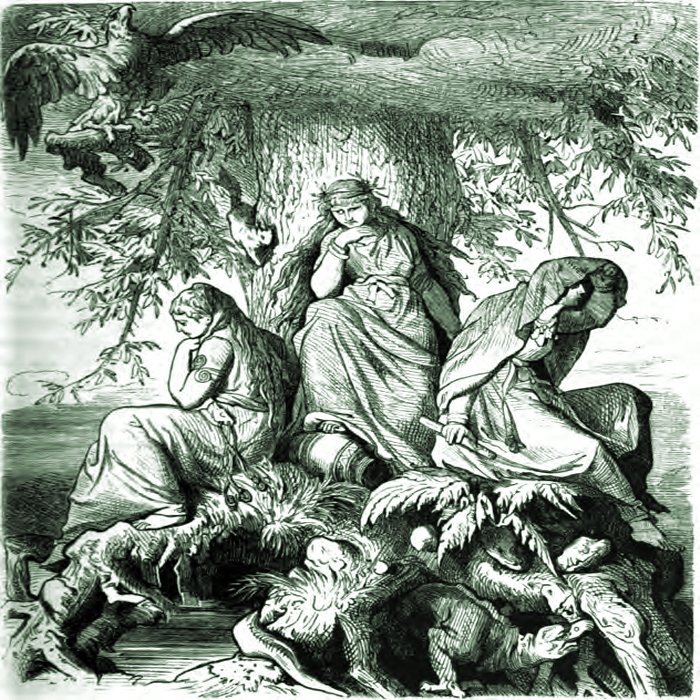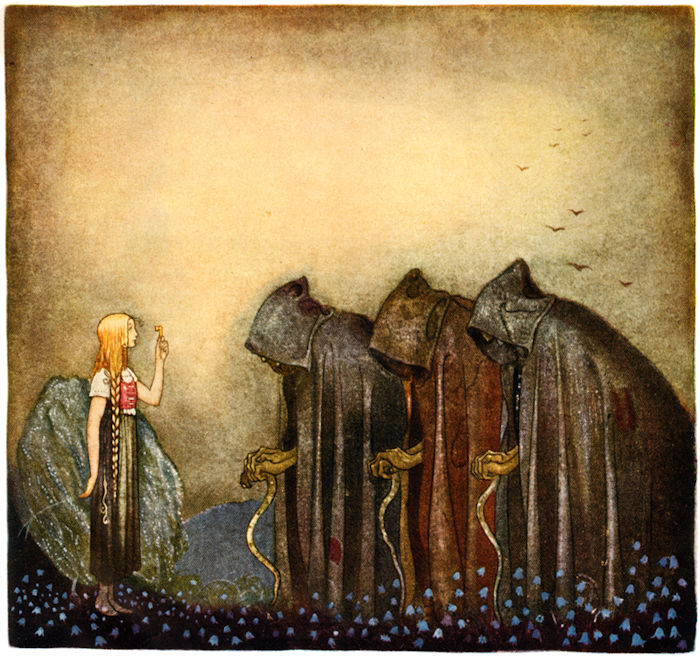A. Sutherland - AncientPages.com - In Old Norse mythology, the Norns were 'Shapers of Destiny.' These goddesses ruled the fates of people and determined individuals' destinies and lifespans.
The Norns were the equivalent of the Greek Moirai ('the Fates), responsible for destiny and personification of a single, unavoidable fate.
The Norns Urðr, Verðandi, and Skuld under the world oak Yggdrasil. Illustration, 1882 by Ludwig Burger via Wikipedia
The Aesir gods had a wonderful life before these three mysterious female beings arrived. At first, they built Asgard and then enjoyed springtime and peaceful days. When the Golden Age ended, the three Norns came from Jotunheimr, a location associated with the Jötnar (giants) in Norse mythology.
Three principal and very powerful Norns lived in the mysterious well of Urd ('fate'), which had its location beneath one of the roots of the giant ash tree - Yggdrasil (World Tree"), which formed a column linking the realms of the gods, humankind, the giants and the dead.
The names of these most powerful creatures in Norse mythology were: Urd, which means What once was. This root was named Urd, while the others were Verdandi ('being') and Skuld ('necessity'). Verdandi means What is coming into being, and Skuld means What shall be.
Urd was responsible for the past. She was considered benevolent and blessed people and identified with the arriving moon.
Guldnyckeln by John Bauer (1882–1918). Credit: Public Domain
Verdandi was responsible for the present and identified with the full lunar moon. Verdandi was also considered a benevolent goddess. Skuld, on the other hand, was responsible for the future.
The youngest of the Norns was believed to be cruel and merciless. She decided the life expectancy of the born children and personified the Dying Moon. But there were also other Norns, benevolent (of divine lineage), who could influence lives positively and malevolent, who had enough power to reverse a person's fortune and send nightmares.
According to the Völuspá ( Old Norse: "Sibyl's Prophecy") poem consisting of about 65 short stanzas on Norse cosmogony, the history of the world of gods, men, and monsters from its beginning until the Ragnarok ("Doom of the Gods"), the Norns' cut on wood', which probably means that they used to carve magical runes on the trunk of the sacred Yggdrasil.
The custom of recording dates and numbers of days and years by cutting notches into the wooden walls of the home – is ancient in Norway. The Norns could also record the days in a person's life.
According to Gylfaginning, other Norns, both benevolent and malevolent, had enough power to reverse a person's fortune.
The Norns had a custom to visit each newly born child to determine events in its life. A specific runic inscription discovered in a church in Borgund in Norway informs as follows:
"The Norns determine good and bad things, and they have brought great sorrow to me…" (also translated as follows: "The Norns have done both good and evil." No one had as much power and wisdom as they did.
Who were these mysterious supernatural females? They differed in their origin, and they may have come from dwarves (as the daughters of the dwarf Dvalin), giants, elves, and the Aesir themselves.
The Norn's origin explains a person's quality of life and fortune, believed to protect the individual.
The Norns are mentioned in countless passages in ancient Scandinavian literature, and strong faith in these beings continued long after the introduction of Christianity.
Updated on January 20, 2024
Written by A. Sutherland - AncientPages.com Staff Writer,
Copyright © AncintPages.com All rights reserved. This material may not be published, broadcast, rewritten or ,redistributed in whole or part without the express written permission of AncientPages.com








